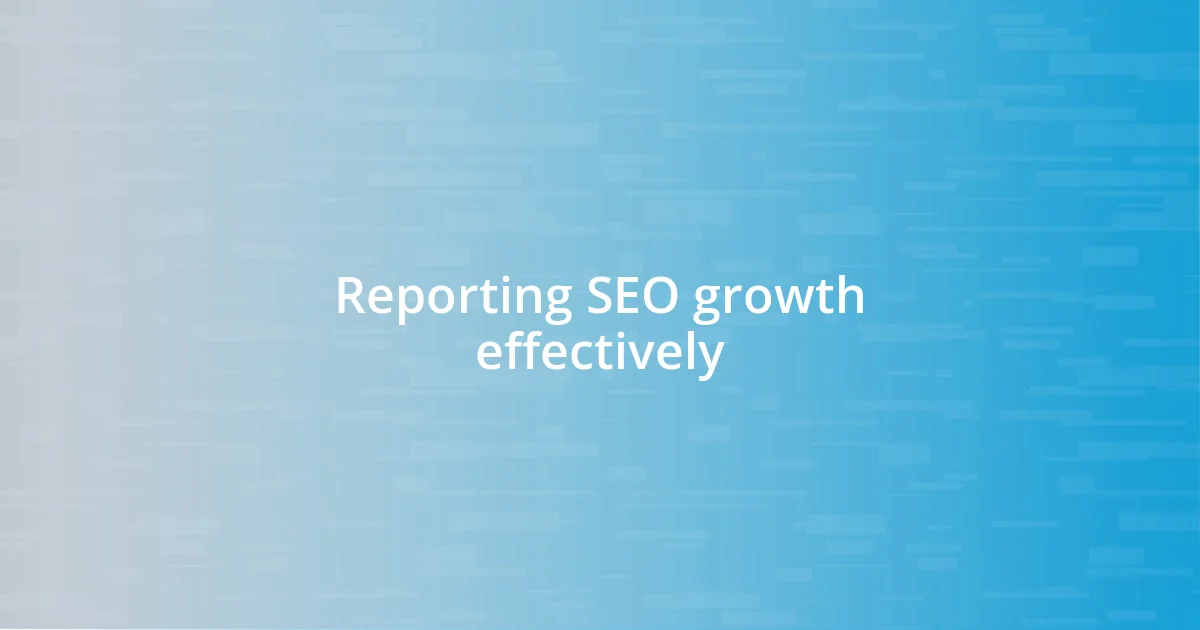Key takeaways:
- Tracking SEO progress involves setting clear benchmarks and monitoring key metrics such as organic traffic, bounce rate, and conversion rate to evaluate effectiveness and guide strategy adjustments.
- Utilizing the right tools like Google Analytics, SEMrush, and Ahrefs enhances data collection and analysis, helping to inform actionable strategies for improvement.
- Regular reporting and storytelling through data can engage stakeholders, highlight success, and justify future SEO investments while fostering a collaborative team environment.

Understanding SEO progress tracking
Tracking SEO progress isn’t just about numbers; it’s about understanding the story behind those numbers. I remember when I first dived into SEO, I got so caught up in keyword rankings that I overlooked other crucial metrics. Have you ever felt overwhelmed by data but unsure what it really meant? It’s vital to look beyond surface-level trends and consider how they align with your overall goals.
One essential aspect of tracking SEO progress is setting clear benchmarks for your objectives. Early on in my journey, I began documenting my website’s traffic, engagement rates, and conversion metrics. I quickly learned that without context—like understanding what was driving that growth—I was missing the big picture. How do you assess success in your SEO efforts? By comparing your progress against past performances, you can gain meaningful insights into what’s working and what needs re-evaluation.
Another important element is utilizing the right tools to gather comprehensive data. When I started using platforms like Google Analytics and SEMrush, it felt like unlocking a treasure chest of information. However, I discovered that merely collecting data isn’t enough; analysis is key. Have you ever ended up with a pile of reports, unsure where to begin? The real magic happens when you interpret that data—turning numbers into actionable strategies that fuel your growth.

Key metrics to monitor
When it comes to monitoring SEO progress, several key metrics stand out. One metric I always prioritize is organic traffic. Observing shifts in this area not only reveals how effective your SEO strategies are but also highlights trends in user behavior over time. It’s fascinating how a small change in your content can lead to a significant spike in visitors; I remember optimizing a blog post and was stunned by the sudden surge in traffic.
Another pivotal metric to keep an eye on is bounce rate. That number represents how many visitors leave your site after viewing just one page. High bounce rates often signal that your content may not be resonating with your audience. I’ve learned to analyze this metric closely—once, I realized a particular page had a 75% bounce rate! By tweaking the content and improving internal linking, I managed to reduce it substantially. Isn’t it amazing how even minor adjustments can enhance user engagement?
Lastly, conversion rates provide direct insight into the effectiveness of your SEO strategy in relation to your business objectives. This metric is crucial because it reflects how well your traffic turns into action, whether that’s a purchase, a sign-up, or another desired outcome. Early on, while focusing just on attracting visitors, I neglected conversions. It wasn’t until I tracked this metric that I understood the importance of not just getting people to my site, but getting them to take meaningful actions.
| Metric | Why It Matters |
|---|---|
| Organic Traffic | Indicates effectiveness of SEO efforts and user engagement |
| Bounce Rate | High rates can signal irrelevant content or poor user experience |
| Conversion Rate | Measures success in driving meaningful actions from visitors |

Tools for tracking SEO results
When it comes to tools for tracking SEO results, my go-to favorites have evolved over the years based on my personal experiences and needs. I initially felt overwhelmed by the options; however, discovering the right ones made a world of difference. For instance, I remember stumbling upon Ahrefs during a particularly frustrating phase of my SEO journey. The insight it offered into backlink profiles and competitor analysis was enlightening, helping me pivot my strategies effectively.
Here are some essential tools I recommend for tracking SEO results:
- Google Analytics: Essential for monitoring traffic statistics and user behavior.
- SEMrush: Great for keyword tracking and competitor analysis.
- Ahrefs: Excellent for understanding backlink profiles and site audits.
- Google Search Console: Offers valuable insights into search performance and indexing issues.
- Moz: Helps in tracking keyword rankings and site health over time.
Each of these tools has its own strengths, and discovering how to leverage them has significantly enriched my understanding of my SEO efforts. I recall the thrill of using Google Search Console to uncover indexing errors, which had been holding back my site’s visibility. Remediation led to a noticeable increase in organic traffic, reinforcing the idea that the right tools can illuminate the path to SEO success.

Setting SEO performance benchmarks
Setting clear SEO performance benchmarks is crucial for tracking your progress effectively. In my experience, having specific, measurable goals helps keep efforts focused. For instance, I set benchmarks for organic traffic, aiming for a gradual increase each month. This not only gives me direction but also allows for quick adjustments if I notice a dip—after all, isn’t it exhilarating to have tangible targets to strive for?
One approach I’ve found valuable is comparing my current performance to historical data. I once analyzed a three-month period after implementing new content strategies, and seeing a 30% rise in organic traffic compared to the previous quarter was a big motivator. That kind of data makes it easier to celebrate small wins along the way. How often do we overlook these moments of success? Tracking these benchmarks regularly ensures they don’t go unnoticed.
Another important aspect of setting benchmarks is relating them to broader business objectives. For example, I link my SEO goals with product launches or sales campaigns. When I launched a new service, I established a target conversion rate and monitored the corresponding organic traffic. Not only did it keep me accountable, but it also created an exciting narrative for my team, turning SEO performance into a story of success we could all share in.

Analyzing competitors’ SEO performance
Understanding how my competitors perform in SEO has been a game changer for me. When I started digging into their strategies, I was surprised to see patterns emerge in their keyword usage and content focus. I remember one instance where a competitor was consistently ranking high for a specific long-tail keyword I had overlooked; that insight prompted me to adjust my content strategy and target that term more aggressively. Hasn’t it happened to you that a single piece of information opens a door to new opportunities?
Using tools like SEMrush and Ahrefs, I could dissect my competitors’ backlink profiles. I vividly recall the first time I discovered several high-authority sites linking to one of my rivals. It hit me hard, but rather than feeling defeated, it sparked my creativity. I realized I could potentially reach out for similar backlinks with my unique angles. This perspective shift transformed my approach from passive observation to an active strategy for growth.
Moreover, analyzing competitors often reveals gaps in their content that I can fill. There was a time when I noticed that a competitor had ignored a trending topic related to my niche. Capitalizing on that, I crafted a comprehensive article that not only addressed the topic but also provided insights that weren’t covered elsewhere. The result? Increased traffic and engagement. Isn’t it fascinating how a little research can lead to such rewarding outcomes?

Adjusting strategies based on data
When it comes to adjusting strategies based on data, I often find it’s about interpreting the numbers to tell a story. During one campaign, I noticed an unexpected drop in my ranking for a key term. Instead of panicking, I dove into the analytics and discovered that a recent Google update had affected the landscape. By tweaking my content to align better with current SEO best practices, I was able to bounce back. It’s incredible how a little analysis can turn setbacks into opportunities, don’t you think?
One of my memorable experiences happened when I tracked bounce rates across different landing pages. I was initially excited until I realized that one particular page had a bounce rate of nearly 80%. Digging deeper revealed that the content didn’t match user intent. By shifting the focus to addressing the specific questions users were asking, I significantly reduced the bounce rate. It was a lightbulb moment for me—data isn’t just numbers; it’s feedback from our audience asking for something different.
Furthermore, adjusting strategies means staying flexible and open to new trends. I’ve learned that being too rigid can hinder progress. For instance, when I saw a rise in interest around voice search, I immediately incorporated conversational keywords into my blog posts. This wasn’t just a guess; it was based on actual search trends. Watching my traffic grow as a result felt gratifying, reminding me that adapting based on data is not just smart—it can also be thrilling. Isn’t the evolution of SEO a captivating journey?

Reporting SEO growth effectively
When I report on my SEO growth, I like to break it down into digestible segments that tell a compelling story. For instance, I remember a particular quarterly report where I highlighted key metrics like organic traffic growth and conversion rates alongside visual graphs. Seeing those upward trends side by side was motivating, not just for me but for my team as well. Have you ever noticed how a well-structured report can spark excitement and engagement among stakeholders?
Another key aspect of reporting effectively involves setting clear benchmarks. Reflecting on a project where I established monthly KPIs, I found that having specific goals in place made it easier to track progress. When we met or exceeded those targets, the team felt a shared sense of accomplishment that fueled our drive moving forward. It’s interesting—how do you celebrate your small wins in SEO?
Additionally, I’ve learned the power of storytelling through data. One time, I combined analytics with customer feedback to showcase how specific content adjustments led to improved user experience. Presenting this narrative not only illustrated growth but also helped in building a stronger case for future investments in SEO strategies. Isn’t it captivating how data can transform into a narrative that resonates with both numbers and emotions?














